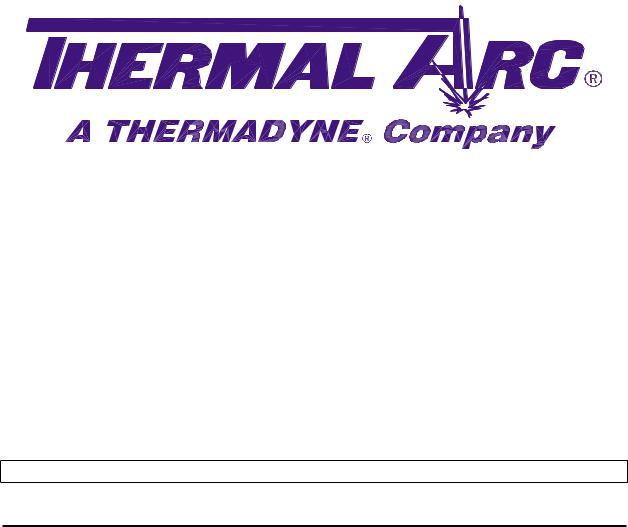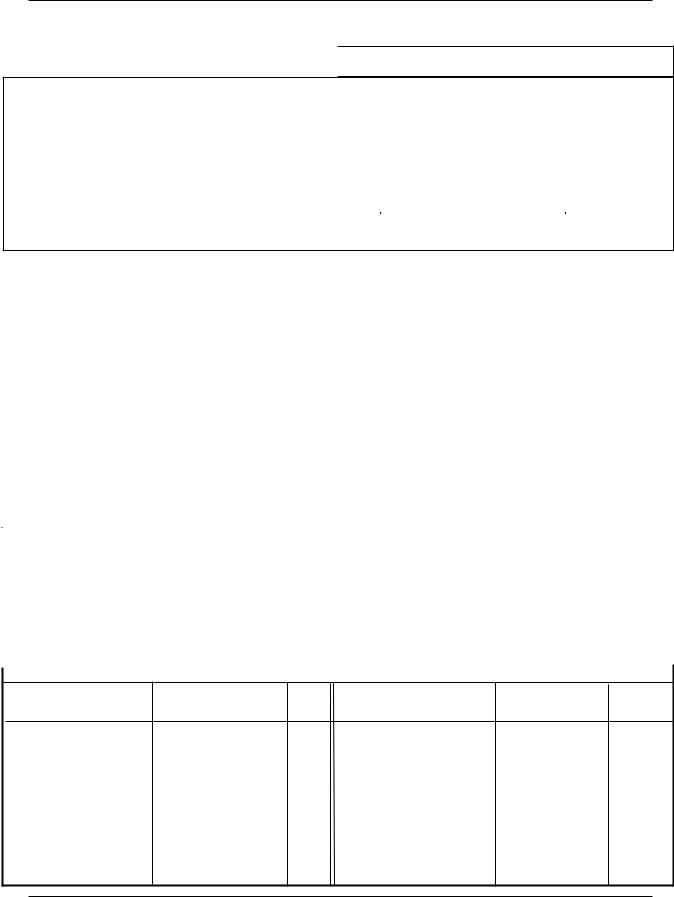Tweco Hefty II User Manual

HEFTY® II STAINLESS
SEMIAUTOMATIC, SOLID STATE CONTROLLED
VOLTAGE SENSING WIRE FEEDER
For the Following Specs:
• 100052-1
OWNER’S MANUAL Number 430429-456 (Rev AB)
Revised June 5, 2000
IMPORTANT: Read these instructions before installing, operating, or servicing this system.
THERMAL ARC INC., TROY, OHIO 45373-1085, U.S.A.

|
430429-456 |
|
TABLE OF CONTENTS |
|
|
INTRODUCTION |
1 |
How To Use This Manual . . . . . . . . . . . . . . . . . . . . . . . . . . . . . . . . . . 1-1 |
|
Equipment Identification . . . . . . . . . . . . . . . . . . . . . . . |
. . . . . . . . . . . 1-1 |
Receipt Of Equipment . . . . . . . . . . . . . . . . . . . . . . . . |
. . . . . . . . . . . 1-1 |
ARC WELDING SAFETY INSTRUCTIONS AND WARNINGS |
2 |
DESCRIPTION OF EQUIPMENT |
3 |
General . . . . . . . . . . . . . . . . . . . . . . . . . . . . . . . . |
. . . . . . . . . . . 3-1 |
Product Specifications . . . . . . . . . . . . . . . . . . . . . . . . |
. . . . . . . . . . . 3-1 |
Features/Benefits . . . . . . . . . . . . . . . . |
. . . . . . . . . . . . . . . . . . . . . . 3-2 |
|
Meanings Of Markings And Graphical Symbols |
|
. . . . . . . . . . . . . . . . . . . . . . 3-3 |
Front Panel Controls And Connections . . . . |
. . . . . . . . . . . . . . . . . . . . . . . 3-4 |
|
Internal Controls And Connections (Component Side) |
. . . . . . . . . . . . . . . . . . . 3-5 |
Internal Controls And Connections (Wire Spool Side) |
. . . . . . . . . . . . . . . . . . . 3-6 |
Description Of Feedhead Assembly . . . . . . . . . |
. . . . . . . . . . . . . . . . . . . 3-6 |
Power Source Compatibility . . . . . . . . . . . . . |
. . . . . . . . . . . . . . . . . . . 3-7 |
Available Options . . . . . . . . . . . . . . . . . . . |
. . . . . . . . . . . . . . . . . . . 3-8 |
INSTALLATION |
|
|
|
4 |
Connections . . . . . . . . . . . . . . . . . . . . . . . . |
. . |
. . |
. . |
. . . . . . . . . . . 4-1 |
Installation Of Welding Wire Spool . . . . . . . . . . . . |
. . |
. . |
. . |
. . . . . . . . . . . 4-1 |
Adjustment Of Spool Tension . . . . . . . . . . . . . . . |
. . |
. . |
. . |
. . . . . . . . . . . 4-1 |
Input And Output Wire Guide Installation . . . . . . . . . |
. . |
. . |
. . |
. . . . . . . . . . . 4-1 |
Selection And Installation Of Feed Rolls . . . . . . . . . |
. . |
. . |
. . |
. . . . . . . . . . . 4-1 |
Welding Gun Compatibility And Installation . . . . . . . . . . . . . . . . . . . . . . . . . 4-2 Threading Wire Into Feedhead . . . . . . . . . . . . . . . . . . . . . . . . . . . . . . . 4-2
OPERATION |
5 |
Prewelding Procedure . . . . . . . . . . . . . . . . . . . . . |
. . . . . . . . . . . . . . 5-1 |
Welding Procedure . . . . . . . . . . . . . . . . . . . . . . . |
. . . . . . . . . . . . . . 5-2 |
Welding In CC Mode vs. CV Mode . . . . . . . . . . . . . . . |
. . . . . . . . . . . . . . 5-2 |
Theory Of Operation . . . . . . . . . . . . . . . . . . . . . . |
. . . . . . . . . . . . . . 5-2 |
Adjusting Burnback Time . . . . . . . . . . . . . . . . . . . . |
. . . . . . . . . . . . . . 5-2 |
Calibrating Wire Feed Speed Meter . . . . . . . . . . . . . . |
. . . . . . . . . . . . . . 5-3 |
Protection And Safety Circuits . . . . . . . . . . . . . . . . . |
. . . . . . . . . . . . . . 5-3 |
MAINTENANCE |
6 |
Cleaning Of The Unit |
. . . . . . . . . . . . . . . . . . . . . . . . . . . . . . . . . . . . 6-1 |
Cleaning Of The Feed Rolls |
. . . . . . . . . . . . . . . . . . . . . . . . . . . . . . . . 6-1 |
Feedhead Maintenance . . . . . . . . . . . . . . . . . . . . . . . . . . . . . . . . . . . 6-1 |
|
Contactor Maintenance . . |
. . . . . . . . . . . . . . . . . . . . . . . . . . . . . . . . . 6-1 |
Gas Valve Maintenance . . . . . . . . . . . . . . . . . . . . . . . . . . . . . . . . . . 6-1
TROUBLESHOOTING |
7 |
Scope . . . . . . . . . . . . . . . . . . . . . . . . . |
. |
. |
. |
. |
. |
. |
. |
. . . . . . . . . . . . 7-1 |
|
|||||||||||
Safety . . . . . . . . . . . . . . . . . . . . . . . . . |
. |
. |
. |
. |
. |
. |
. |
. . . . . . . . . . . . 7-1 |
|
|||||||||||
Troubleshooting Hints . . . . . . . . . . . . . . . . . |
. . . . . . . . |
. |
. |
. |
. |
. |
. |
. |
. |
. |
. |
. 7-1 |
|
|||||||
Troubleshooting Guide . . . . . . . . . . . . . . . . |
. . . . . . . . |
. |
. |
. |
. |
. |
. |
. |
. |
. |
. |
. 7-2 |
|
|||||||
|
|
|
|
|
|
|
|
|
|
|
|
|
|
|
|
|
|
|
|
|
June 5, 2000 Revised |
|
|
|
|
|
|
|
|
|
|
|
|
|
|
|
|
|
|
Page 1 |
|

430429-456
TABLE OF CONTENTS
PARTS LIST |
8 |
Equipment Identification |
. . . . . . . . . . . . . . . . . . . . . . . . . . . . . . . . . . 8-1 |
How To Use This Parts List . . . . . . . . . . . . . . . . . . . . . . . . . . . . . . . . . 8-1
DIAGRAMS
WARRANTY
Page 2 |
November 17, 1999 |

430429-456 INTRODUCTION
INTRODUCTION
How To Use This Manual:
This Owner’s Manual usually applies to just the underlined specification or part numbers listed on the cover. If none are underlined, they are all covered by this manual.
Throughout this manual, the words WARNING, CAUTION, and NOTE may appear. Pay particular attention to the information provided under these headings. These special annotations are easily recognized as follows:
WARNING gives information regarding possible personal injury. Warnings will be enclosed in a box such as this.
CAUTION refers to possible equipment damage. Cautions will be shown in bold type.
NOTE offers helpful information concerning certain operating procedures. Notes will be shown in italics.
Equipment Identification:
The unit’s identification number (specification or part number), model, and serial number usually
appear on a nameplate attached to the control panel. In some cases, the nameplate may be attached to the rear panel. Equipment which does not have a control panel such as gun and cable assemblies is identified only by the specification or part number printed on the shipping container. Record these numbers for future reference.
Receipt Of Equipment:
When you receive the equipment, check it against the invoice to make sure it is complete and inspect the equipment for possible damage due to shipping. If there is any damage, notify the carrier immediately to file a claim. Furnish complete information concerning damage claims or shipping errors to Thermal Arc, Order Department, 2200 Corporate Drive, Troy, Ohio 45373-1085. Include all equipment identification numbers as described above along with a full description of the parts in error.
Move the equipment to the installation site before uncrating the unit. Use care to avoid damaging the equipment when using bars, hammers, etc., to uncrate the unit.
Additional copies of this manual may be purchased by contacting Thermal Arc at the address given above. Include the Owner’s Manual number and equipment identification numbers.
November 17, 1999 |
1-1 |

430429-456 INTRODUCTION
This page intentionally left blank.
1-2 |
November 17, 1999 |

ARC WELDING SAFETY INSTRUCTIONS AND WARNINGS
Instruction 830001
ARC WELDING SAFETY INSTRUCTIONS AND WARNINGS
ARC WELDING can be hazardous.
PROTECT YOURSELF AND OTHERS FROM POSSIBLE SERIOUS INJURY OR DEATH. KEEP CHILDREN AWAY. PACEMAKER WEARERS KEEP AWAY UNTIL CONSULTING YOUR DOCTOR. DO NOT LOSE THESE INSTRUCTIONS. READ OPERATING/INSTRUCTION MANUAL BEFORE INSTALLING, OPERATING OR SERVICING THIS EQUIPMENT.
Welding products and welding processes can cause serious injury or death, or damage to other equipment or property, if the operator does not strictly observe all safety rules and take precautionary actions.
Safe practices have developed from past experience in the use of welding and cutting. These practices must be learned through study and training before using this equipment. Anyone not having extensive training in welding and cutting practices should not attempt to weld. Certain of the practices apply to equipment connected to power lines; other practices apply to engine driven equipment.
Safe practices are outlined in the American National Standard Z49.1 entitled: SAFETY IN WELDING AND CUTTING. This publication and other guides to what you should learn before operating this equipment are listed at the end of these safety precautions.
HAVE ALL INSTALLATION, OPERATION, MAINTENANCE, AND REPAIR WORK PERFORMED ONLY BY QUALIFIED PEOPLE.
|
|
|
|
|
ELECTRIC SHOCK can kill. |
6. |
Turn off all equipment when not in use. Disconnect power to |
|
|
|
|
|
Touching live electrical parts can cause fatal shocks |
|
equipment if it will be left unattended or out of service. |
|
|
|
|
|
7. Use fully insulated electrode holders. Never dip holder in water |
||
|
|
|
|
|
or severe burns. The electrode and work circuit is |
||
|
|
|
|
|
|
to cool it or lay it down on the ground or the work surface. Do not |
|
|
|
|
|
|
electrically live whenever the output is on. The input |
|
|
|
|
|
|
|
|
touch holders connected to two welding machines at the same |
|
|
|
|
|
|
power circuit and machine internal circuits are also |
|
|
|
|
|
|
|
|
time or touch other people with the holder or electrode. |
|
|
|
|
|
|
live when power is on. In semiautomatic or automatic |
|
|
|
|
|
|
|
8. Do not use worn, damaged, undersized, or poorly spliced cables. |
||
|
|
|
|
|
wire welding, the wire, wire reel, drive roll housing, |
||
|
|
|
|
|
and all metal parts touching the welding wire are |
9. |
Do not wrap cables around your body. |
|
|
|
|
|
electrically live. Incorrectly installed or improperly |
10. |
Ground the workpiece to a good electrical (earth) ground. |
|
|
|
|
|
grounded equipment is a hazard. |
11. |
Do not touch electrode while in contact with the work (ground) |
|
|
|
|
|
|||
|
|
|
|
|
|
||
|
1. |
Do not touch live electrical parts. |
|
circuit. |
|||
|
2. |
Wear dry, hole-free insulating gloves and body protection. |
12. |
Use only well-maintained equipment. Repair or replace damaged |
|||
|
3. Insulate yourself from work and ground using dry insulating mats |
|
parts at once. |
||||
|
|
or covers. |
13. |
In confined spaces or damp locations, do not use a welder with |
|||
|
4. |
Disconnect input power or stop engine before installing or serv- |
|
AC output unless it is equipped with a voltage reducer. Use |
|||
|
|
icing this equipment. Lock input power disconnect switch open, |
|
equipment with DC output. |
|||
|
|
or remove line fuses so power cannot be turned on accidentally. |
14. |
Wear a safety harness to prevent falling if working above floor |
|||
|
5. Properly install and ground this equipment according to its |
|
level. |
||||
|
|
Owner’s Manual and national, state, and local codes. |
15. |
Keep all panels and covers securely in place. |
|||
|
|
|
|
|
|
|
|
|
|
|
|
|
|
|
|
|
|
|
|
|
ARC RAYS can burn eyes and skin; |
1. |
Wear a welding helmet fitted with a proper shade of filter (see |
|
|
|
|
|
NOISE can damage hearing. |
|
ANSI Z49.1 listed in Safety Standards) to protect your face and |
|
|
|
|
|
|
|
eyes when welding or watching. |
|
|
|
|
|
|
2. |
Wear approved safety glasses. Side shields recommended. |
|
|
|
|
|
Arc rays from the welding process produce intense |
3. |
Use protective screens or barriers to protect others from flash |
|
|
|
|
|
heat and strong ultraviolet rays that can burn eyes |
|
and glare; warn others not to watch the arc. |
|
|
|
|
|
and skin. Noise from some processes can damage |
4. |
Wear protective clothing made from durable, flame-resistant |
|
|
|
|
|
hearing. |
||
|
|
|
|
|
|
material (wool and leather) and foot protection. |
|
|
|
|
|
|
|
|
|
|
|
|
|
|
|
5. |
Use approved ear plugs or ear muffs if noise level is high. |
|
|
|
|
|
|
|
|
Eye protection filter shade selector for welding or cutting (goggles or helmet), from AWS A6.2-73.
|
Electrode Size |
Filter |
Welding or Cutting |
Metal Thickness |
Shade |
Operation |
or Welding Current |
No. |
Torch soldering |
— |
2 |
Torch brazing |
— |
3 or 4 |
Oxygen cutting |
|
3 or 4 |
Light |
Under 1 in., 25 mm |
|
Medium |
1 to 6 in., 25-150 mm |
4 or 5 |
Heavy |
Over 6 in., 150 mm |
5 or 6 |
Gas welding |
|
4 or 5 |
Light |
Under 1/8 in., 3 mm |
|
Medium |
1/8 to 1/2 in., 3-12 mm |
5 or 6 |
Heavy |
Over 1/2 in., 12 mm |
6 or 8 |
Shielded metal-arc welding |
Under 5/32 in., 4 mm |
10 |
(stick) electrodes |
5/32 to 1/4 in., 4 to 6.4 mm |
12 |
|
Over 1/4 in., 6.4 mm |
14 |
Welding or Cutting |
Electrode Size |
Metal Thickness |
|
Operation |
or Welding Current |
Gas metal-arc welding (MIG) |
|
Non-ferrous base metal |
All |
Ferrous base metal |
All |
Gas tungsten arc welding (TIG) |
All |
Atomic hydrogen welding |
All |
Carbon arc welding |
All |
Plasma arc welding |
All |
Carbon arc air gouging |
|
Light |
|
Heavy |
|
Plasma arc cutting |
|
Light |
Under 300 Amp |
Medium |
300 to 400 Amp |
Heavy |
Over 400 Amp |
Filter
Shade
No.
11
12
12
12
12
12
12
14
9
12
14
May 8, 1996 |
2-1 |

ARC WELDING SAFETY INSTRUCTIONS AND WARNINGS
Instruction 830001
FUMES AND GASES can be hazardous to your health.
Welding produces fumes and gases. Breathing these fumes and gases can be hazardous to your health.
1.Keep your head out of the fumes. Do not breath the fumes.
2.If inside, ventilate the area and/or use exhaust at the arc to remove welding fumes and gases.
3.If ventilation is poor, use an approved air-supplied respirator.
4.Read the Material Safety Data Sheets (MSDSs) and the manufacturer’s instruction for metals, consumables, coatings, and cleaners.
5.Work in a confined space only if it is well ventilated, or while wearing an air-supplied respirator. Shielding gases used for welding can displace air causing injury or death. Be sure the breathing air is safe.
6.Do not weld in locations near degreasing, cleaning, or spraying operations. The heat and rays of the arc can react with vapors to form highly toxic and irritating gases.
7.Do not weld on coated metals, such as galvanized, lead, or cadmium plated steel, unless the coating is removed from the weld area, the area is well ventilated, and if necessary, while wearing an air-supplied respirator. The coatings and any metals containing these elements can give off toxic fumes if welded.
WELDING can cause fire or explosion.
Sparks and spatter fly off from the welding arc. The flying sparks and hot metal, weld spatter, hot workpiece, and hot equipment can cause fires and burns. Accidental contact of electrode or welding wire to metal objects can cause sparks, overheating, or fire.
1.Protect yourself and others from flying sparks and hot metal.
2.Do not weld where flying sparks can strike flammable material.
3.Remove all flammables within 35 ft (10.7 m) of the welding arc. If this is not possible, tightly cover them with approved covers.
4.Be alert that welding sparks and hot materials from welding can easily go through small cracks and openings to adjacent areas.
5.Watch for fire, and keep a fire extinguisher nearby.
6.Be aware that welding on a ceiling, floor, bulkhead, or partition can cause fire on the hidden side.
7.Do not weld on closed containers such as tanks or drums.
8.Connect work cable to the work as close to the welding area as practical to prevent welding current from traveling long, possibly unknown paths and causing electric shock and fire hazards.
9.Do not use welder to thaw frozen pipes.
10.Remove stick electrode from holder or cut off welding wire at contact tip when not in use.
11.Wear oil-free protective garments such as leather gloves, heavy shirt, cuffless trousers, high shoes, and a cap.
FLYING SPARKS AND HOT METAL can cause injury.
Chipping and grinding cause flying metal. As welds cool, they can throw off slag.
1.Wear approved face shield or safety goggles. Side shields recommended.
2.Wear proper body protection to protect skin.
CYLINDERS can explode if damaged.
Shielding gas cylinders contain gas under high pressure. If damaged, a cylinder can explode. Since gas cylinders are normally part of the welding process, be sure to treat them carefully.
1.Protect compressed gas cylinders from excessive heat, mechanical shocks, and arcs.
2.Install and secure cylinders in an upright position by chaining them to a stationary support or equipment cylinder rack to prevent falling or tipping.
3.Keep cylinders away from any welding or other electrical circuits.
4.Never allow a welding electrode to touch any cylinder.
5.Use only correct shielding gas cylinders, regulators, hoses, and fittings designed for the specific application; maintain them and associated parts in good condition.
6.Turn face away from valve outlet when opening cylinder valve.
7.Keep protective cap in place over valve except when cylinder is in use or connected for use.
8.Read and follow instructions on compressed gas cylinders, associated equipment, and CGA publication P-1 listed in Safety Standards.
|
|
|
ENGINES can be hazardous. |
|
|
|
|
|
ENGINE EXHAUST GASES can kill. |
1. |
Use equipment outside in open, well-ventilated areas. |
|
Engines produce harmful exhaust gases. |
2. |
If used in a closed area, vent engine exhaust outside and away |
|
|
from any building air intakes. |
|
|
|
|
|
2-2 |
May 8, 1996 |

ARC WELDING SAFETY INSTRUCTIONS AND WARNINGS
Instruction 830001
ENGINE FUEL can cause fire or explosion.
Engine fuel is highly flammable.
2.Do not add fuel while smoking or if unit is near any sparks or open flames.
3.Allow engine to cool before fueling. If possible, check and add fuel to cold engine before beginning job.
|
|
|
1. Stop engine before checking or adding fuel. |
4. |
Do not overfill tank — allow room for fuel to expand. |
|
|
|
|
5. |
Do not spill fuel. If fuel is spilled, clean up before starting engine. |
|
|
|
|
|
|
|
|
|
|
|
|
|
|
|
MOVING PARTS can cause injury. |
3. |
Have only qualified people remove guards or covers for mainte- |
|
|
|
Moving parts, such as fans, rotors, and belts can cut |
|
nance and troubleshooting as necessary. |
|
|
|
fingers and hands and catch loose clothing. |
4. |
To prevent accidental starting during servicing, disconnect nega- |
|
|
|
|
|
tive (-) battery cable from battery. |
|
|
|
|
|
1.Keep all doors, panels, covers, and guards closed and securely in place.
2.Stop engine before installing or connecting unit.
5.Keep hands, hair, loose clothing, and tools away from moving parts.
6.Reinstall panels or guards and close doors when servicing is finished and before starting engine.
SPARKS can cause BATTERY GASES TO EXPLODE; BATTERY ACID can burn eyes and skin.
Batteries contain acid and generate explosive gases.
1.Always wear a face shield when working on a battery.
2.Stop engine before disconnecting or connecting battery cables.
3.Do not allow tools to cause sparks when working on a battery.
4.Do not use welder to charge batteries or jump start vehicles.
5.Observe correct polarity (+ and –) on batteries.
STEAM AND PRESSURIZED HOT COOLANT can burn face, eyes, and skin.
The coolant in the radiator can be very hot and under pressure.
1.Do not remove radiator cap when engine is hot. Allow engine to cool.
2.Wear gloves and put a rag over cap area when removing cap.
3.Allow pressure to escape before completely removing cap.
WARNING: This product, when used for welding or cutting, produces fumes or gases which contain chemicals known to the State of California to cause birth defects and, in some cases, cancer. (California Health & Safety Code Sec. 25249.5 et seq.)
NOTE: Considerations About Welding And The Effects Of Low Frequency Electric And Magnetic Fields
The following is a quotation from the General Conclusions Section of the U.S. Congress, Office of Technology Assessment, Biological Effects of Power Frequency Electric & Magnetic Fields — Background Paper, OTA-BP-E-63 (Washington, DC: U.S. Government Printing Office, May 1989): “... there is now a very large volume of scientific findings based on experiments at the cellular level and from studies with animals and people which clearly establish that low frequency magnetic fields can interact with, and produce changes in, biological systems. While most of this work is of very high quality, the results are complex. Current scientific understanding does not yet allow us to interpret the evidence in a single coherent framework. Even more frustrating, it does not yet allow us to draw definite conclusions about questions of possible risk or to offer clear science-based advice on strategies to minimize or avoid potential risks.”
To reduce magnetic fields in the workplace, use the following procedures:
1.Keep cables close together by twisting or taping them.
2.Arrange cables to one side and away from the operator.
3.Do not coil or drape cables around the body.
4.Keep welding power source and cables as far away from body as practical.
About Pacemakers:
The above procedures are among those also normally recommended for pacemaker wearers. Consult your doctor for complete information.
PRINCIPAL SAFETY STANDARDS
Safety in Welding and Cutting, ANSI Standard Z49.1, from American Welding Society, 550 N.W. LeJeune Rd., Miami, FL 33126.
Safety and Health Standards, OSHA 29 CFR 1910, from Superintendent of Documents, U.S. Government Printing Office, Washington, D.C. 20402.
Recommended Safe Practices for the Preparation for Welding and Cutting of Containers That Have Held Hazardous Substances, American Welding Society Standard AWS F4.1, from American Welding Society, 550 N.W. LeJeune Rd., Miami, FL 33126.
National Electrical Code, NFPA Standard 70, from National Fire Protection Association, Batterymarch Park, Quincy, MA 02269.
Safe Handling of Compressed Gases in Cylinders, CGA Pamphlet P-1, from Compressed Gas Association, 1235 Jefferson Davis Highway, Suite 501, Arlington, VA 22202.
Code for Safety in Welding and Cutting, CSA Standard W117.2, from Canadian Standards Association, Standards Sales, 178 Rexdale Boulevard, Rexdale, Ontario, Canada M9W 1R3.
Safe Practices for Occupation and Educational Eye and Face Protection, ANSI Standard Z87.1, from American National Standards Institute, 1430 Broadway, New York, NY 10018.
Cutting and Welding Processes, NFPA Standard 51B, from National Fire Protection Association, Batterymarch Park, Quincy, MA 02269.
May 8, 1996 |
2-3 |

ARC WELDING SAFETY INSTRUCTIONS AND WARNINGS
Instruction 830001
This page intentionally left blank.
2-4 |
May 8, 1996 |

PRECAUTIONS DE SECURITE EN SOUDAGE A L'ARC
Instruction 830002
PRECAUTIONS DE SECURITE EN SOUDAGE A L′ARC
LE SOUDAGE A L′ARC EST DANGEREUX
PROTEGEZ-VOUS, AINSI QUE LES AUTRES, CONTRE LES BLESSURES GRAVES POSSIBLES OU LA MORT. NE LAISSEZ PAS LES ENFANTS S’APPROCHER, NI LES PORTEURS DE STIMULATEUR CARDIAQUE (A MOINS QU’ILS N’AIENT CONSULTE UN MEDECIN). CONSERVEZ CES INSTRUCTIONS. LISEZ LE MANUEL D’OPERATION OU LES INSTRUCTIONS AVANT D’INSTALLER, UTILISER OU ENTRETENIR CET EQUIPEMENT.
Les produits et procédés de soudage peuvent sauser des blessures graves ou la mort, de même que des dommages au reste du matériel et à la propriété, si l’utilisateur n’adhère pas strictement à toutes les règles de sécurité et ne prend pas les précautions nécessaires.
En soudage et coupage, des pratiques sécuritaires se sont développées suite à l’expérience passée. Ces pratiques doivent être apprises par étude ou entraînement avant d’utiliser l’equipement. Toute personne n’ayant pas suivi un entraînement intensif en soudage et coupage ne devrait pas tenter de souder. Certaines pratiques concernent les équipements raccordés aux lignes d’alimentation alors que d’autres s’adressent aux groupes électrogènes.
La norme Z49.1 de l’American National Standard, intitulée “SAFETY IN WELDING AND CUTTING” présente les pratiques sécuritaires à suivre. Ce document ainsi que d’autres guides que vous devriez connaître avant d’utiliser cet équipement sont présentés à la fin de ces instructions de sécurité.
SEULES DES PERSONNES QUALIFIEES DOIVENT FAIRE DES TRAVAUX D’INSTALLATION, DE REPARATION, D’ENTRETIEN ET D’ESSAI.
L’E L E C T R O C U T IO N P E U T ET R E MORTELLE.
Une décharge électrique peut tuer ou brûler gravement. L’électrode et le circuit de soudage sont sous tension dès la mise en circuit. Le circuit d’alimentation et les circuits internes de l’é quipement sont aussi sous tension dès la mise en marche. En soudage automatique ou semi-automatique avec fil, ce dernier, le rouleau ou la bobine de fil, le logement des galets d’entrainement et toutes les pièces métalliques en contact avec le fil de soudage sont sous tension. Un équipement inadéquatement
installé ou inadéquatement mis à la terre est dangereux.
1.Ne touchez pas à des pièces sous tension.
2.Portez des gants et des vêtements isolants, secs et non troués.
3.Isolez-vous de la pièce à souder et de la mise à la terre au moyen de tapis isolants ou autres.
4.Déconnectez la prise d’alimentation de l’équipement ou arrêtez le moteur avant de l’installer ou d’en faire l’entretien. Bloquez le commutateur en circuit ouvert ou enlevez les fusibles de l’alimentation afin d’éviter une mise en marche accidentelle.
5.Veuillez à installer cet équipement et à le mettre à la terre selon le manuel d’utilisation et les codes nationaux, provinciaux et locaux applicables.
6.Arrêtez tout équipement après usage. Coupez l’alimentation de l’équipement s’il est hors d’usage ou inutilisé.
7.N’utilisez que des porte-électrodes bien isolés. Ne jamais plonger les porte-électrodes dans l’eau pour les refroidir. Ne jamais les laisser traîner par terre ou sur les pièces à souder. Ne touchez pas aux porte-électrodes raccordés à deux sources de courant en même temps. Ne jamais toucher quelqu’un d’autre avec l’électrode ou le porte-électrode.
8.N’utilisez pas de câbles électriques usés, endommagés, mal épissés ou de section trop petite.
9.N’enroulez pas de câbles électriques autour de votre corps.
10.N’utilisez qu’une bonne prise de masse pour la mise à la terre de la pièce à souder.
11.Ne touchez pas à l’électrode lorsqu’en contact avec le circuit de soudage (terre).
12.N’utilisez que des équipements en bon état. Réparez ou remplacez aussitôt les pièces endommagées.
13.Dans des espaces confinés ou mouillés, n’utilisez pas de source de courant alternatif, à moins qu’il soit muni d’un réducteur de tension. Utilisez plutôt une source de courant continu.
14.Portez un harnais de sécurité si vous travaillez en hauteur.
15.Fermez solidement tous les panneaux et les capots.
LE RAYONNEMENT DE L′ARC PEUT
BRÛ LER LES YEUX ET LA PEAU; LE
BRUIT PEUT ENDOMMAGER L′OUIE.
L’arc de soudage produit une chaleur et des rayons ultraviolets intenses, susceptibles de brûler les yeux et la peau. Le bruit causé par certains procédés peut endommager l’ouïe.
1.Portez une casque de soudeur avec filtre oculaire de nuance appropriée (consultez la norme ANSI Z49 indiquée ci-après)
pour vous protéger le visage et les yeux lorsque vous soudez ou que vous observez l’exécution d’une soudure.
2.Portez des lunettes de sécurité approuvées. Des écrans latéraux sont recommandés.
3.Entourez l’aire de soudage de rideaux ou de cloisons pour protéger les autres des coups d’arc ou de l’éblouissement; avertissez les observateurs de ne pas regarder l’arc.
4.Portez des vêtements en matériaux ignifuges et durables (laine et cuir) et des chaussures de sécurité.
5.Portez un casque antibruit ou des bouchons d’oreille approuvés lorsque le niveau de bruit est élevé.
8-V-96 |
2-1 |

PRECAUTIONS DE SECURITE EN SOUDAGE A L'ARC
Instruction 830002
SELECTION DES NUANCES DE FILTRES OCULAIRES POUR LA PROTECTION DES YEUX EN COUPAGE ET SOUDAGE ( selon AWS A 8.2-73 )
Opération |
Dimension d’électrode ou |
Nuance de |
de |
Epaisseur de métal ou |
de filtre |
Coupage ou soudage |
Intensité de courant |
oculaire |
Brasage tendre au chalumeau |
toutes conditions |
2 |
Brasage fort au chalumeau |
toutes conditions |
3 ou 4 |
Oxycoupage |
|
|
mince |
moins de 1 po. (25 mm) |
2 ou 3 |
moyen |
de 1 à 6 po. (25 à 150 mm) |
4 ou 5 |
épais |
plus de 6 po. (150 mm) |
5 ou 6 |
Soudage aux gaz |
|
|
mince |
moins de 1/8 po. (3 mm) |
4 ou 5 |
moyen |
de 1/8 à 1/2 po. (3 à 12 mm) |
5 ou 6 |
épais |
plus de 1/2 po. (12 mm) |
6 ou 8 |
Soudage à l’arc avec |
moins de 5/32 po. (4 mm) |
10 |
electrode enrobées (SMAW) |
de 5/32 à 1/4 po. (4 à 6.4 mm) |
12 |
Soudage à l’arc sous gaz |
plus de 1/4 po. (6.4 mm) |
14 |
|
|
|
avec fil plein (GMAW) |
|
|
métaux non-ferreux |
toutes conditions |
11 |
métaux ferreux |
toutes conditions |
12 |
Soudage à l’arc sous gaz |
|
|
avec électrode de tungstène (GTAW) |
toutes conditions |
12 |
Soudage à l’hydrogène |
|
|
atomique (AHW) |
toutes conditions |
12 |
Soudage à l’arc avec |
|
|
électrode de carbone (CAW) |
toutes conditions |
12 |
Soudage à l’arc Plasma (PAW) |
toutes dimensions |
12 |
Gougeage Air-Arc avec |
|
|
électrode de carbone |
|
|
mince |
|
12 |
épais |
|
14 |
Coupage à l’arc Plasma (PAC) |
|
|
mince |
moins de 300 ampères |
9 |
moyen |
de 300 à 400 ampères |
12 |
épais |
plus de 400 ampères |
14 |
|
|
|
LES VAPEURS ET LES FUMEES SONT DANGEREUSES POUR LA SANTE.
Le soudage dégage des vapeurs et des fumées dangereuses à respirer.
1.Eloignez la tête des fumées pour éviter de les respirer.
2.A l’intérieur, assurez-vous que l’aire de soudage est bien ventilée ou que les fumées et les vapeurs sont aspirées à l’arc.
3.Si la ventilation est inadequate, portez un respirateur à adduction d’air approuvé.
4.Lisez les fiches signalétiques et les consignes du fabricant relatives aux métaux, aux produits consummables, aux revêtements et aux produits nettoyants.
5.Ne travaillez dans un espace confiné que s’il est bien ventilé; sinon, portez un respirateur à adduction d’air. Les gaz protecteurs de soudage peuvent déplacer l’oxygène de l’air et ainsi causer des malaises ou la mort. Assurez-vous que l’air est propre à la respiration.
6.Ne soudez pas à proximité d’opérations de dégraissage, de nettoyage ou de pulvérisation. La chaleur et les rayons de l’arc peuvent réagir avec des vapeurs et former des gaz hautement toxiques et irritants.
7.Ne soudez des tôles galvanisées ou plaquées au plomb ou au cadmium que si les zones à souder ont été grattées à fond, que si l’espace est bien ventilé; si nécessaire portez un respirateur à adduction d’air. Car ces revêtements et tout métal qui contient ces éléments peuvent dégager des fumées toxiques au moment du soudage.
2-2 |
8-V-96 |

PRECAUTIONS DE SECURITE EN SOUDAGE A L'ARC
Instruction 830002
LE SOUDAGE PEUT CAUSER UN INCENDIE OU UNE EXPLOSION
L’arc produit des étincellies et des projections. Les particules volantes, le métal chaud, les projections de soudure et l’équipement surchauffé peuvent causer un incendie et des brûlures. Le contact accidentel de l’électrode ou du fil-électrode avec un
objet métallique peut provoquer des étincelles, un échauffement ou un incendie.
1.Protégez-vous, ainsi que les autres, contre les étincelles et du métal chaud.
2.Ne soudez pas dans un endroit où des particules volantes ou des projections peuvent atteindre des matériaux inflammables.
3.Enlevez toutes matières inflammables dans un rayon de 10, 7 mètres autour de l’arc, ou couvrez-les soigneusement avec des bâches approuvées.
4.Méfiez-vous des projections brulantes de soudage susceptibles de pénétrer dans des aires adjacentes par de petites ouvertures ou fissures.
5.Méfiez-vous des incendies et gardez un extincteur à portée de la main.
6.N’oubliez pas qu’une soudure réalisée sur un plafond, un plancher, une cloison ou une paroi peut enflammer l’autre côté.
7.Ne soudez pas un récipient fermé, tel un réservoir ou un baril.
8.Connectez le câble de soudage le plus près possible de la zone de soudage pour empêcher le courant de suivre un long parcours inconnu, et prévenir ainsi les risques d’électrocution et d’incendie.
9.Ne dégelez pas les tuyaux avec un source de courant.
10.Otez l’électrode du porte-électrode ou coupez le fil au tube-con- tact lorsqu’inutilisé après le soudage.
11.Portez des vêtements protecteurs non huileux, tels des gants en cuir, une chemise épaisse, un pantalon revers, des bottines de sécurité et un casque.
LES ETINCELLES ET LES PROJEC- T I O N S B R U L A N T E S PE U V EN T CAUSER DES BLESSURES.
Le piquage et le meulage produisent des particules métalliques volantes. En refroidissant, la soudure peut projeter du éclats de laitier.
1.Portez un écran facial ou des lunettes protectrices approuvées. Des écrans latéraux sont recommandés.
2.Portez des vêtements appropriés pour protéger la peau.
LES BOUTEILLES ENDOMMAGEES PEUVENT EXPLOSER
Les bouteilles contiennent des gaz protecteurs sous haute pression. Des bouteilles endommagées peuvent exploser. Comme les bouteilles font normalement partie du procédé de soudage, traitezles avec soin.
1.Protégez les bouteilles de gaz comprimé contre les sources de chaleur intense, les chocs et les arcs de soudage.
2.Enchainez verticalement les bouteilles à un support ou à un cadre fixe pour les empêcher de tomber ou d’être renversées.
3.Eloignez les bouteilles de tout circuit électrique ou de tout soudage.
4.Empêchez tout contact entre une bouteille et une électrode de soudage.
5.N’utilisez que des bouteilles de gaz protecteur, des détendeurs, des boyauxs et des raccords conçus pour chaque application spécifique; ces équipements et les pièces connexes doivent être maintenus en bon état.
6.Ne placez pas le visage face à l’ouverture du robinet de la bouteille lors de son ouverture.
7.Laissez en place le chapeau de bouteille sauf si en utilisation ou lorsque raccordé pour utilisation.
8.Lisez et respectez les consignes relatives aux bouteilles de gaz comprimé et aux équipements connexes, ainsi que la publication P-1 de la CGA, identifiée dans la liste de documents ci-dessous.
LES GAZ D’ECHAPPEMENT DES MOTEURS PEUVENT ETRE MORTELS.
Les moteurs produisent des gaz d’é chappement nocifs.
LES MOTEURS PEUVENT ETRE DANGEREUX
1.Utilisez l’é quipement à l’extérieur dans des aires ouvertes et bien ventilées.
2.Si vous utilisez ces équipements dans un endroit confiné, les fumées d’échappement doivent être envoyées à l’extérieur, loin des prises d’air du bâtiment.
LE CARBURANT PEUR CAUSER UN INCENDIE OU UNE EXPLOSION.
Le carburant est hautement inflammable.
1. Arrêtez le moteur avant de vérifier le niveau de carburant ou de faire le plein.
2.Ne faites pas le plein en fumant ou proche d’une source d’étincelles ou d’une flamme nue.
3.Si c’est possible, laissez le moteur refroidir avant de faire le plein de carburant ou d’en vérifier le niveau au début du soudage.
4.Ne faites pas le plein de carburant à ras bord: prévoyez de l’espace pour son expansion.
5.Faites attention de ne pas renverser de carburant. Nettoyez tout carburant renversé avant de faire démarrer le moteur.
8-V-96 |
2-3 |

PRECAUTIONS DE SECURITE EN SOUDAGE A L'ARC
Instruction 830002
DES PIECES EN MOUVEMENT PEUVENT CAUSER DES BLESSURES.
Des pièces en mouvement, tels des ventilateurs, des rotors et des courroies peuvent couper doigts et mains, ou accrocher des vêtements amples.
1.Assurez-vous que les portes, les panneaux, les capots et les protecteurs soient bien fermés.
2.Avant d’installer ou de connecter un système, arrêtez le moteur.
3.Seules des personnes qualifiées doivent démonter des protecteurs ou des capots pour faire l’entretien ou le dépannage nécessaire.
4.Pour empêcher un démarrage accidentel pendant l’entretien, débranchez le câble d’accumulateur à la borne négative.
5.N’approchez pas les mains ou les cheveux de pièces en mouvement; elles peuvent aussi accrocher des vêtements amples et des outils.
6.Réinstallez les capots ou les protecteurs et fermez les portes après des travaux d’entretien et avant de faire démarrer le moteur.
DES ETINCELLES PEUVENT FAIRE EX- P LO S E R U N A C C U M U LA T E U R ; L’ELECTROLYTE D’UN ACCUMULATEUR PEUT BRULER LA PEAU ET LES YEUX.
Les accumulateurs contiennent de l’é lectrolyte acide et dégagent des vapeurs explosives.
1.Portez toujours un écran facial en travaillant sur un accumulateur.
2.Arrêtez le moteur avant de connecter ou de déconnecter des câbles d’accumulateur.
3.N’utilisez que des outils anti-étincelles pour travailler sur un accumulateur.
4.N’utilisez pas une source de courant de soudage pour charger un accumulateur ou survolter momentanément un véhicule.
5.Utilisez la polarité correcte (+ et –) de l’accumulateur.
LA VAPEUR ET LE LIQUIDE DE REFROIDISSEMENT BRULANT SOUS PRESSION PEUVENT BRULER LA PEAU ET LES YEUX.
Le liquide de refroidissement d’un radiateur peut être brûlant et sous pression.
1.N’ôtez pas le bouchon de radiateur tant que le moteur n’est pas refroidi.
2.Mettez des gants et posez un torchon sur le bouchon pour l’ôter.
3.Laissez la pression s’échapper avant d’ôter complètement le bouchon.
PRINCIPALES NORMES DE SECURITE
Safety in Welding and Cutting, norme ANSI Z49.1, American Welding Society, 550 N.W. LeJeune Rd., Miami, FL 33128.
Safety and Health Standards, OSHA 29 CFR 1910, Superintendent of Documents, U.S. Government Printing Office, Washington, D.C. 20402.
Recommended Safe Practices for the Preparation for Welding and Cutting of Containers That Have Held Hazardous Substances, norme AWS F4.1, American Welding Society, 550 N.W. LeJeune Rd., Miami, FL 33128.
National Electrical Code, norme 70 NFPA, National Fire Protection Association, Batterymarch Park, Quincy, MA 02269.
Safe Handling of Compressed Gases in Cylinders, document P-1, Compressed Gas Association, 1235 Jefferson Davis Highway, Suite 501, Arlington, VA 22202.
Code for Safety in Welding and Cutting, norme CSA W117.2 Association canadienne de normalisation, Standards Sales, 276 Rexdale Boulevard, Rexdale, Ontario, Canada M9W 1R3.
Safe Practices for Occupation and Educational Eye and Face Protection, norme ANSI Z87.1, American National Standards Institute, 1430 Broadway, New York, NY 10018.
Cutting and Welding Processes, norme 51B NFPA, National Fire Protection Association, Batterymarch Park, Quincy, MA 02269.
2-4 |
8-V-96 |

430429-456 DESCRIPTION OF EQUIPMENT
DESCRIPTION OF EQUIPMENT
General:
The HEFTY II STAINLESS is a portable, solid state controlled, voltage sensing wire feeder that operates on arc voltage and can be used with most constant voltage (CV) and constant current (CC) DC-type power sources. The only connection required between the power source and the wire feeder is the welding cable.
The unique design of this wire feeder allows operation in a constant wire feed speed mode when used with CV power sources, and in a voltage sensing wire feed speed mode (wire feed speed varies with respect to arc voltage) when used with CC power sources.
The stainless steel case totally encloses the solid state control circuitry, welding wire, and wire drive system. A hinged, latched door allows quick and easy access to the welding wire and feedhead assembly that features quick change, gear-driven feed rolls and a hand operated knob for clamping the welding gun into the feedhead.
The HEFTY II STAINLESS comes with an abundance of standard features, which include: (1) on/off rocker switch, (2) wire feed speed control knob, (3) inch/purge switch, (4) carrying handle, (5) contactor, (6) gas valve, (7) CC/CV mode switch,
(8) input circuit breaker for complete system protection, (9) electronic controlled protection circuitry to protect against an undervoltage, an overvoltage, a voltage spike, a shorted or locked motor, a shorted
contactor coil, and a shorted gas valve, (10) electronic controlled dynamic brake, (11) electronic controlled current limit to motor, (12) electronic controlled start circuit for improved arc starting, (13) low voltage gun trigger circuit for operator safety, and (14) a feed roll kit for 0.035 and 0.045 size filler wire.
The HEFTY II STAINLESS has been designed to comply with CSA NRTL/C and NEMA EW 3 standards.
Product Specifications:
Input Voltage Range .......................... |
|
15 - 100 VDC |
|
Input Frequency ..................................... |
|
|
0 Hz (DC) |
Maximum Input Current.............................. |
|
|
8 Amps |
Wire Speed Range |
|
|
|
(Dependent On Arc Voltage) |
.......... 50 - 700 IPM |
||
..................................................... |
|
(1.3 - 17.8 MPM) |
|
Wire Sizes ........................................ |
|
0.024 - 5/64" |
|
......................................................... |
|
(0.6 - 2.0 mm) |
|
Maximum Wire Spool Capacity ...... |
12" (304.8 mm) |
||
....................................................... |
|
30 Lbs. (13.6 kg) |
|
Feed Rolls ............................. |
2 (Both Gear Driven) |
||
Welding Current (I)........... |
330A at 60% Duty Cycle |
||
Welding Gun Diameter....................... |
|
5/8" Nominal |
|
Maximum Shielding Gas Inlet Pressure |
....... 75 PSI |
||
Weight (Less Wire)...................... |
|
38 Lbs. (17.2 kg) |
|
Approvals .......................................... |
|
CSA NRTL/C |
|
........................................................... |
|
NEMA EW 3 |
|
Figure 3-1 Dimensional Information
June 5, 2000 Revised |
3-1 |

430429-456
DESCRIPTION OF EQUIPMENT
Features/Benefits:
1. |
Operates On Arc Voltage |
A. Can be used with most constant current (CC) or con- |
|
|
stant voltage (CV) DC-type power sources |
|
|
B. No control cables required |
2. |
Voltage Sensing Control Circuit With |
A. Allows voltage sensing wire feed speed operation when |
|
CC/CV Switch |
used with CC power sources |
|
B. Allows constant wire feed speed operation when used |
|
|
|
|
|
|
with CV power sources |
|
|
|
3. |
Solid State Circuitry |
A. Improves wire speed accuracy |
|
|
B. Compensates for motor load variations |
|
|
C. Provides current limit to contactor, gas valve, and motor |
4. |
Polarity Insensitive |
A. Operates on either straight or reverse polarity |
|
|
|
5. |
Electronic Controlled Start Circuit |
A. Enhances arc starting performance with CC power |
|
|
sources |
6. |
Electronic Brake |
A. Solid state control of an electronic brake offers quick |
|
|
stopping of the motor to prevent wire overrun |
7. |
Standard Contactor |
A. Allows the welding wire to remain electrically “cold” until |
|
|
the gun switch trigger is depressed |
|
|
B. Increases operator safety |
8. |
Standard Gas Valve |
A. Controls the “on/off” flow of shielding gas |
|
|
|
9. |
Powerful, Permanent Magnet DC Drive |
A. Accommodates the fast speed demands of small diameter |
|
Motor |
wire |
|
B. Accommodates the low speed, high torque demands of |
|
|
|
|
|
|
large diameter wire |
|
|
|
10. |
Replaceable Motor Brushes |
A. Provides economical means of extending motor life |
|
|
|
11. |
Needle Bearing Construction On Motor |
A. Reduces friction and extends bearing life over a |
|
Output Shaft |
sleeving bearing |
|
|
|
|
|
|
12. |
Input Circuit Breaker |
A. Ensures complete system protection |
|
|
|
13. |
Electronic Controlled Protection Circuitry |
A. Protects electronics from undervoltage, overvoltage, |
|
|
and voltage spikes. |
|
|
B. Protects electronics from a shorted or locked motor |
|
|
C. Protects electronics from a shorted contactor coil |
|
|
D. Protects electronics from a shorted gas valve coil |
14. |
Stainless Steel Case |
A. Provides strength in a small, portable, light weight |
|
|
package |
|
|
B. Allows easy access for difficult to reach jobs |
15. |
Standard Inch/Purge Switch |
A. Allows “cold” inching of wire at set wire feed speed |
|
|
B. Allows purging of gas without running wire |
16. |
Carrying Handle |
A. Promotes portability |
|
|
|
17. |
Quick Change Feed Rolls |
A. Allows operator to change feed rolls without the use of |
|
|
tools |
|
|
B. Both feed rolls are gear driven for better feeding of wire |
18. |
Gun Clamp Knob |
A. Allows operator to secure welding gun without the use |
|
|
of tools |
19. |
Feed Roll Pressure Release |
A. Allows operator to adjust feed roll pressure without the |
|
|
use of tools |
|
|
B. Allows operator to change feed rolls or wire while |
|
|
retaining preset feed roll pressure |
|
|
|
3-2 |
November 17, 1999 |
